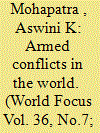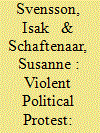|
|
|
Sort Order |
|
|
|
Items / Page
|
|
|
|
|
|
|
| Srl | Item |
| 1 |
ID:
139351


|
|
|
|
|
| Summary/Abstract |
To sum up, what accounts for the rising incidence of internal armed conflicts in plural societies is the interplay of variety of factors ranging from the nature of the polity (i.e. liberal/transitional democratic or autocratic), stage of economic development, level of integration and state-society engagement to the process of state formation and national identity construction.
|
|
|
|
|
|
|
|
|
|
|
|
|
|
|
|
| 2 |
ID:
137787


|
|
|
|
|
| Summary/Abstract |
One of the goals of peacekeeping operations is limiting the amount of violence that takes place during a civil war. However, peacekeeping forces cannot occupy every part of a country that is engulfed in a civil conflict. This raises the question as to where peacekeeping forces decide to go once they are deployed to a civil war-torn country. In this article, we contribute to the burgeoning research that examines peacekeeping at the microlevel by attempting to determine whether peacekeeping operations go to those areas that are in most need of their help. Utilizing geocoded data from the UCDP GED and PKOLED projects, we use spatial analysis techniques to create kernel density estimates of civil war violence and peacekeeping operations at site-specific locations. We then use these newly generated variables in a variety of regression models to determine whether the location of civil war battles influences the location of peacekeepers. The analysis confirms our expectations in that the location of violence significantly predicts the location of peacekeeping operations, but only after these operations have been in a civil war-torn country for a considerable length of time. Contrary to our expectations, however, peacekeeping operations do not seem more adept at identifying and responding to government and rebel violence relative to attacks against civilians
|
|
|
|
|
|
|
|
|
|
|
|
|
|
|
|
| 3 |
ID:
187394


|
|
|
|
|
| Summary/Abstract |
This article presents the Uppsala Conflict Data Program (UCDP) “Violent Political Protest” (VPP) data set: a new –standalone- category of organized violence, which complements, and is compatible with, UCDP’s three categories of organized violence: one-sided violence, non-state, and state-based conflict. It consists of violent political protests, with at least 25 casualties during a year, in which informally organized civilians challenge states over governmental or territorial issues. We describe the data collection process, and demonstrate the data’s use with empirical analyses. Violent political protest is present globally, but most prevalent in the Middle East and Africa, and increasingly common over time. Violent political protest frequently co-occurs with state-based conflicts, but rarely due to conflict escalation. We explore if this is due to shared contexts, and find that gender inequality increases the likelihood of VPP onset, similar to state-based conflicts. Finally, we identify avenues for future research, including using VPP to assist in a more precise and complete analysis of organized violence.
|
|
|
|
|
|
|
|
|
|
|
|
|
|
|
|
|
|
|
|
|